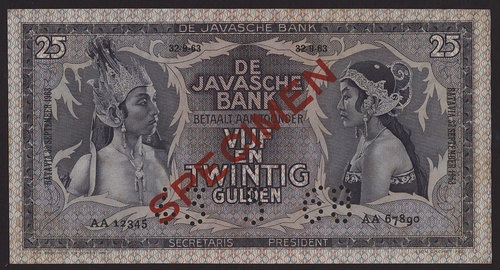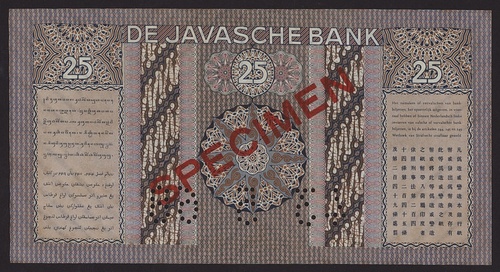Auction: 25008 - World Banknotes
Lot: 456
(x) De Javasche Bank. Netherlands Indies, Specimen 25 Gulden, 1963, serial number range AA12345 - AA67890,
This 25 Gulden specimen note, is a striking artifact from the era of the De Javasche Bank, an institution that played a crucial role in the financial systems of the Dutch East Indies. This note, with its printed date of “32 -9 - 1963”, was never intended for circulation. The date itself is a deliberate impossibility—no calendar can feature a 32nd day of any month—making this an unmistakable specimen intended to demonstrate the design, not for use as legal tender. Additionally, the note is perforated with the cancellation “43 - 5 - 68”, further marking it as a post-closure demonstration piece. These deliberate and visible anomalies ensure there can be no confusion with actual currency.
The De Javasche Bank was established in 1828 to serve as the central bank of the Dutch East Indies, issuing all paper currency in the colony and controlling monetary policy. The 25 Gulden note, while not among the highest denominations in circulation, would have been a significant sum for many during its era. The note's value would place it in the hands of merchants, traders, and those engaged in substantial financial transactions—indicating the currency’s important role in facilitating the economic exchanges of the colonial system.
The design of this note is both practical and artistic, bearing inscriptions in Dutch, Malay, Javanese, and Chinese. This multilingual aspect reflects the diverse, multi-ethnic society of the Dutch East Indies, where various groups coexisted under colonial rule. The visual elements of the note follow the refined engraving style typical of De Javasche Bank issues, with intricate security features designed to prevent counterfeiting.
De Javasche Bank’s role was not just as a bank, but also as a symbol of Dutch colonial authority. It controlled the currency supply, facilitated trade in valuable natural resources like rubber and coffee, and supported the Dutch colonial infrastructure. However, after the Japanese occupation during World War II and the Indonesian independence struggle, the bank’s role drastically changed. In 1953, following Indonesia’s independence, De Javasche Bank was nationalized, and its role as the central bank was taken over by Bank Indonesia.
This 25 Gulden specimen from 1963 stands as a relic of a time when the Dutch East Indies were still fresh in the memories of many, even as the region transitioned into the independent nation of Indonesia. While never circulated, its continued production after the closure of De Javasche Bank serves as a fascinating reflection on the enduring legacy of colonial institutions, as well as the political and economic shifts of the time. This specimen captures a moment in history, frozen in time and marked with impossible dates and cancellations, offering a glimpse into the complex relationship between the colonial powers and the growing independence movements in Southeast Asia.
When viewed alongside the later 1000 Gulden specimen, issued in 1968 and presented in the next lot, this 25 Gulden note becomes part of a fascinating pair of post-closure specimens that document the final years of De Javasche Bank’s existence. Both notes were intended for archival purposes and never circulated, but together they offer a rare insight into a bygone era and the intricate role currency played in the shifting political landscape of the Dutch East Indies and the new Republic of Indonesia.
(Pick 80s) about uncirculated
Subject to 5% tax on Hammer Price in addition to 20% VAT on Buyer’s Premium.
Estimate
£1,000 to £1,500
Starting price
£1000







